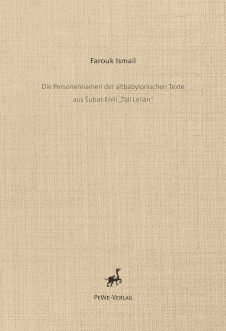
Farouk Ismail
Die Personennamen der altbabylonischen Texte aus Šubat-Enlil „Tall Leilān“.
Format: 13 x 19 cm — Softcover
Umfang: 120 Seiten
ISBN: 978-3-935012-50-8
Preis: 17,80 €
© PeWe-Verlag 2021
Šubat-Enlil und Šeḫna sind jeweils alte Namen des heutigen Tall Leilān in der syrischen Jazīrah (ca. 30 km südöstlich von Qamishli), an dem die Yale University von 1979-2008 Ausgrabungen durchgeführt hat. Dabei wurden wichtige architektonische Funde und zahlreiche altbabylonische Texte aus dem 18. Jahrhundert v. Chr. gefunden.
Es handelt sich um Verwaltungs- und Wirtschaftstexte, Briefe und einige politische Verträge. Ihre besondere Bedeutung liegt darin, dass sie die einzige Quelle zur Geschichte der Region sind für die ca. 35 Jahre, die auf die Zerstörung des Königreichs Mari (ca. 1762 v. Chr.) folgen. In jener Zeit war Šubat-Enlil die Hauptstadt des Königreichs „Apum“, welches den größten Teil der Gebiete östlich des Jaghjagh-Flusses umfasste.
Die Texte enthalten reichliches Material für das Studium von Personen- und Ortsnamen, die zur Erklärung der Ethnizität der Bevölkerung, sowie die historischen Geographie Obermesopotamiens beitragen.
Die vorliegende Studie stellt sich zur Aufgabe, die Personennamen in den bisher veröffentlichten Texten aus Šubat-Enlil zusammenzustellen und philologisch zu untersuchen.
Šubat-Enlil and Šeḫna are respectively ancient names of today’s Tall Leilān in the Syrian Jazīrah (about 30 km southeast of Qamishli), where Yale University conducted excavations from 1979-2008. Important architectural finds and numerous ancient Babylonian texts from the 18th century BC were found.
They are administrative and economic texts, letters and some political treaties. Their special significance lies in the fact that they are the only source on the history of the region for the approx. 35 years following the destruction of the kingdom of Mari (approx. 1762 BC). At that time, Šubat-Enlil was the capital of the kingdom of „Apum“, which comprised most of the territories east of the Jaghjagh River.
The texts contain abundant material for the study of personal and place names, which help to explain the ethnicity of the population, as well as the historical geography of Upper Mesopotamia.
The present study sets itself the task of compiling and philologically examining the personal names in the texts from Šubat-Enlil published to date.